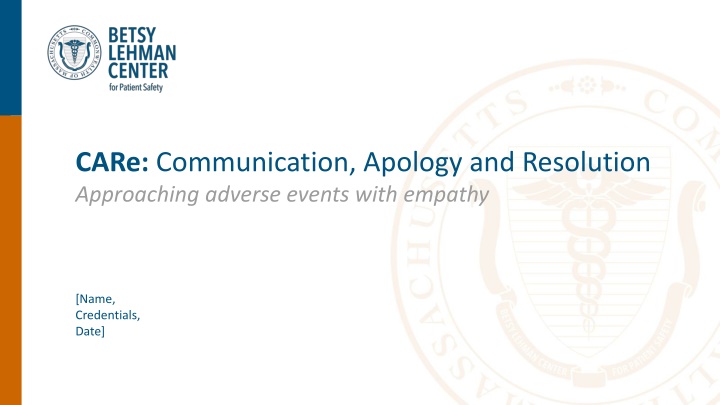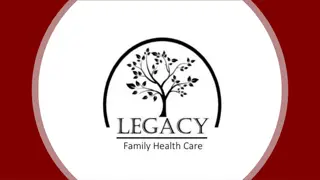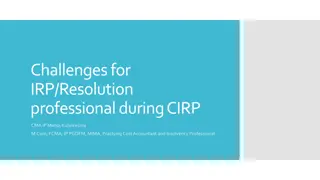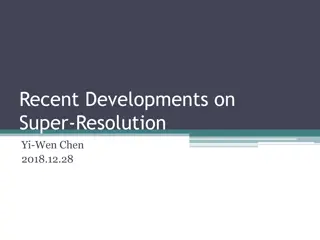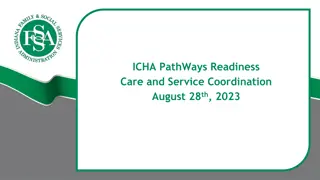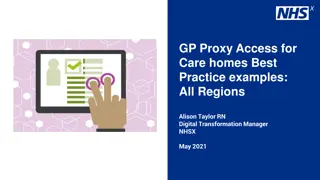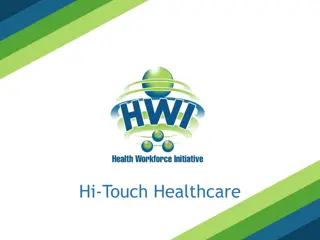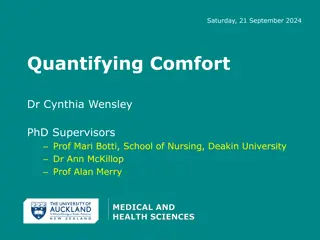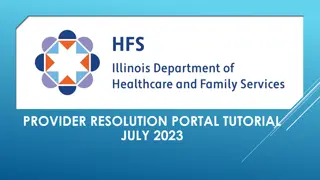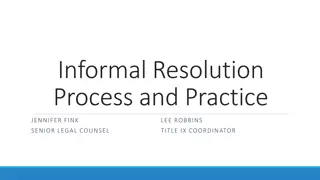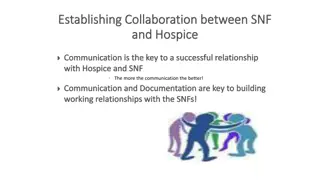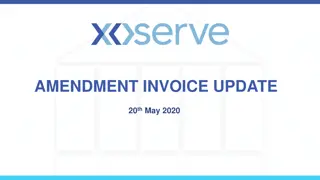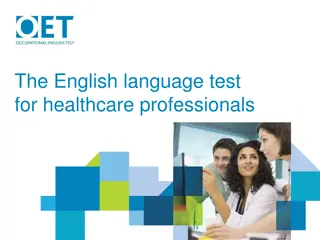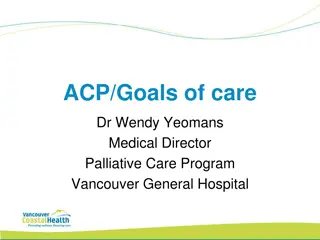CARe Program: Enhancing Communication, Apology, and Resolution in Healthcare
The CARe program focuses on approaching adverse events in healthcare with empathy, emphasizing communication, apology, and resolution. It aims to improve patient outcomes, clinician-patient relationships, and overall healthcare system efficiency by addressing adverse events promptly and transparently. By advocating for open communication, thorough investigations, and fair compensation when appropriate, CARe seeks to shift from a traditional liability model to a patient-centered approach that prioritizes empathy and resolution.
Download Presentation

Please find below an Image/Link to download the presentation.
The content on the website is provided AS IS for your information and personal use only. It may not be sold, licensed, or shared on other websites without obtaining consent from the author.If you encounter any issues during the download, it is possible that the publisher has removed the file from their server.
You are allowed to download the files provided on this website for personal or commercial use, subject to the condition that they are used lawfully. All files are the property of their respective owners.
The content on the website is provided AS IS for your information and personal use only. It may not be sold, licensed, or shared on other websites without obtaining consent from the author.
E N D
Presentation Transcript
CARe: Communication, Apology and Resolution Approaching adverse events with empathy [Name, Credentials, Date]
Objectives Describe: Benefits of the CARe program for patients, clinicians, and health care systems, in comparison to a traditional liability model Essential elements of a successful CARe program Key CARe action steps to take immediately following an adverse event 2
Adverse event DEFINITION An injury that was caused by medical management rather than the patient s underlying condition. Adverse events can result from errors, but not necessarily (i.e., a bad outcome from a procedure, adverse patient reaction to medication)
Why do patients sue? Studies show that the most important factor in people s decisions to file lawsuits is not negligence, but ineffective communication between patients and providers. Malpractice suits often result when an unexpected adverse outcome is met with a lack of empathy from physicians and a perceived or actual withholding of essential information. Clinton & Obama, NEJM 2006 Vincent C, Lancet 1993
Traditional approaches to mistakes Pretend they never happened, don t talk about them. Deny and Defend, anything that is already known, and hope patients never show up in court 6
What is wrong with the status quo? Damaging to patient/provider relationship Inefficient and expensive Impedes patient safety improvement Providers Patients Damaging to future patients Negative health impacts Costly Health Care System Thwarts patient safety improvement Drives over-utilization Drive up overall cost of healthcare Compromises access to care Gallagher Arch Int Med 2006; Boothman, Front. Health Svcs Mgmt 2012. 7
What is CARe? CARe stands for Communication, Apology and Resolution and means: Communicate with patients and families when unanticipated adverse outcomes occur Investigate and explain what happened Implement systems to avoid recurrences of incidents and improve patient safety Where appropriate, apologize and offer fair financial compensation without the patient having to file a lawsuit 8
Principles of CARe Compensate patients quickly and fairly when unreasonable medical care caused injury. If the care was reasonable or did not adversely affect the clinical outcome, support caregivers and the organization vigorously. Reduce patient injuries (and therefore claims) by learning through patients experiences. Source: Nurturing a Culture of Patient Safety and Achieving Lower Malpractice Risk Through Disclosure: Lessons Learned and Future Directions. Boothman, et al; Frontiers of Health Service Management 28:3; study at the University of Michigan Health System. 9
Communication, Apology and Resolution THE BASICS Communicate Apologize Investigate Move toward healing Resolve Proactively communicate with patients/families about adverse events Offer empathy and, where appropriate, an apology of responsibility Investigate the events to find root causes and develop corrective actions to improve patient safety Have resolution conversations to discuss those findings with the patients/families Resolve cases with compensation outside of the court system (patients who may receive compensation are encouraged to have attorneys.) Connect them with team members who can help them throughout CARe Proactively move the case to the insurer for resolution if criteria are met Ensure patient safety improvements are made 11
Why use CARe? Better for patients Treated with compassion and honesty Can get the answers and support they need Fairer and more timely process than court system Better for providers Preserves provider/patient relationship when possible Can express natural empathy and get support they need True systemic root causes are more likely to be unearthed Better for the healthcare system Less defensive medicine System improvements are made Builds trust in the system which can increase reporting and morale 12
CARe data 13
What does the data show?* Claims/costs do not increase even when systematically using the program, and in many cases decrease Providers are supportive of the use of the program Patients are supportive of the use of the program Patients who do not receive the components of the program suffer long-term negative impacts Systematic, rigorous application of the program is needed to receive the full benefits of the program, including improved safety culture *See appendix for complete publication list.
Open communication from providers is linked to lower levels of harm Learn more at BetsyLehmanCenterMA.gov/CostOfMedicalError
Areas of investigation MASSACHUSETTS Data collected Outcomes Institution-level data on volume and costs of claims and lawsuits 1. Institutional liability outcomes Case-specific data for each adverse event that meets study criteria 2. Case level outcomes 3. Provider satisfaction with CARe Survey of providers involved in a CARe case 4. CARe implementation experiences Interviews with key personnel Monthly pilot site check-in calls
The Massachusetts pilot sites Site #Beds Location Teaching (Y/N) Beth Israel Deaconess Medical Center 642 Urban Y BID-Milton 88 Community N BID-Needham 58 Community N Baystate Medical Center 716 Urban Y Baystate Franklin Medical Center 93 Community N Baystate Mary Lane Hospital 31 Community N
Cases tracked in MA study 99 closed (61.9%) Referred to insurer: 160 (16%) Screened in: 991 817 closed (99.5%) Not referred to insurer: 821 (83%) Insurer status not yet determined: 10 (1%) All pending
Conclusions CARe does not lead to an avalanche of new claims or require many cases to be sent to insurer Resolved cases were settled with median payment of $75K (compensation in < 5% of CARe cases); only 9% resulted in compensation Most of the work of CARe is communicating about non-error events
Results: Were there any statistically significant changes (p<0.05) in liability trends? Outcome CARe CRP Hospitals Comparison Hospitals (No CRP) Lower at community hospitals and 1 academic medical center New claims No change Defense costs Lower at both academic medical centers No change New claims receiving compensation No change No change Compensation costs No change No change Average payment per claim No change No change Time to resolution No change No change
Conclusions Large cost savings reported by some early adopters did not occur, but there were no cost increases Hospitals can do the right thing without increasing their liability exposure CRP discussion should move away from liability concerns to how best to implement programs and leverage patient safety improvements
What patient safety improvement ideas has CARe generated? Patient Safety Improvement n Investigation findings shared with involved staff 36 Educational efforts 34 Policy changes 21 Safety alerts sent to staff 14 Input into internal QI system for ongoing analysis 10 New process flow diagrams created and disseminated/posted 10 Human factor engineering analysis 6 Other 10 *n=114 CARe insurer cases
Providers are supportive of CARe overall Overall, how supportive are you of using the CARe process to resolve unanticipated outcomes? (n=108) 70 58 60 50 40 # of respondents 30 17 20 12 9 7 10 2 1 1 1 0 0 1 2 3 4 5 6 7 8 9 10 Extremely unsupportive Score Extremely supportive *74 respondents said they did not know enough to answer this question.
After a medical error Patients and families rarely receive an apology or offer of support following a medical error
After a medical error Open communication from providers is linked to lower levels of harm Data and graphic from the Betsy Lehman Center Cost of Medical Error Report 2019- https://betsylehmancenterma.gov/research/costofme
Factors facilitating successful implementation Deep engagement by high-level physician champions Strong buy-in from risk management Practical support and oversight by project managers No barriers erected by insurer Pre-existing just culture commitment Sense of community and support from MACRMI
CARe adverse event pathway CARe Event occurs Respond immediately to the patient s clinical needs, communicate proactively, express empathy, investigate, make changes to improve patient safety and inform patient of those changes 84% 16% Standard of Care NOT met and caused significant harm Standard of care met or low-level harm CARe Insurer Pathway: In coordination with insurer: explain what happened, formally apologize, proactively offer compensation Explain what happened and answer patient questions; continue to express empathy; option of good will gesture
Defining a CARe case THE FILTER If an internal investigation team determines that: The standard of care was not met, AND The unmet standard of care caused significant harm the case is a CARe Insurer Case, and will follow the insurer protocol. /unsure
CARe insurer case protocol If selected by the filter, case is referred to insurer as CARe case Case reviewed by insurer and external experts CARe cases will proceed with a meeting with insurer, patient, patient s attorney, and providers (if applicable) to formally apologize, discuss the case, and offer compensation 31
CARe insurance case protocol POTENTIAL OUTCOMES
Communication, Apology and Resolution TIMELINE 3-6+ months 2-5 months 1-3 months 2-4 weeks 24-48 hours Determination of CARe criteria fit Insurer reviews case and develops offer parameters Patient Safety Alerted Internal investigation takes place Initial meeting with insurers, providers, patient safety staff, patient, counsel, and other parties. Providers, Chiefs, and Directors consulted Support services for providers and patients launched Patient Safety and Patient Relations maintain contact with providers and patients respectively Provider/System Allocation by insurer Team huddle; designee conducts Initial CARe Communication with the patient; connects them to Insurer for record release Discussion with patient regarding error and known facts Additional meetings occur as necessary. Insurer invites patient to CARe Initial Meeting; recommends that counsel also attend (3) Final offer to patient made and accepted or rejected. (1,2) Lessons learned implemented at site (4,5) (10,11) (6,7,8,9)
Educating clinicians Steps following an adverse event: Step 1: Report the event and get help with communication (Pager system/Reporting System/Call) Step 2: Communicate with the patient/family about the event; be empathetic and use statements of regret ( I am so sorry this happened to you ); discuss facts known at this time and do not speculate or blame others. A note on Apology: 1. Statements of Regret Always! 2. Apology of Fault Once facts are known (if applicable) Step 3: Document the communication with the patient/family in the record; facts, who was present, and results of conversation. Step 4: Check back in with the patient/family and discuss with them the findings and any systemic improvements to be made once all facts are known and root causes have been determined.
Case samples 35
Adverse event SAMPLE CASE Mr. Negashe calls the hospital patient relations office to voice a complaint that his doctor never provided information about blood work drawn during a clinic visit, and that in the meantime he had to be admitted to the hospital. He went to the emergency room when he developed blurry vision and was admitted to the ICU where he learned that he had diabetes. He is worried that his vision problems are permanent. He is now insulin dependent and thinks that may not have been the case if detected earlier. He works as a driver and has been unable to work for several weeks. He is calling to simply to voice his dissatisfaction and alert the hospital to the problem. He does not indicate an expectation.
Adverse event SAMPLE CASE, CONTINUED Patient relations reviews the case and learns that the patient had an elevated HgbA1C several months earlier, and follow-up was encouraged. When he did return, he was seen by the physician, who drew a repeat test but did not follow-up with the patient. The patient called the clinic twice for results and these calls were forwarded to the physician, but no return call was made. The clinic did not have a closed loop system to identify whether calls had been returned. The HgbA1c was markedly elevated on repeat test. Peer review confirms that immediate follow-up was indicated in this situation, as the patient was at significant risk of becoming acutely ill.
Adverse event sample case RESOLUTION Mr. N. received an explanation, an apology and compensation Compensation based on expenses encountered, lost work, pain and suffering Payment was determined and made by hospital s insurer on behalf of the hospital and physician With physician s endorsement, responsibility was apportioned 50/50 Case was shared in multiple institutional forums to prevent recurrence
Adverse event SAMPLE CASE Mrs. Alcott called her PCP s office in September about a CT scan she had in March prior to undergoing an emergent cholecystectomy. She said she heard from a specialist that there were some worrisome findings on it that should have been followed up on. The nurse at the PCP s office read her the report, which noted that a pelvic ultrasound was recommended for further evaluation of an adnexal enlargement. Mrs. Alcott was extremely upset because she had just been diagnosed with ovarian cancer, and asked that a surgeon call her back to explain to her why this was never followed up on. An attending surgeon who was involved in her follow up care from the hospital attempted to contact the patient, but the call was not returned. A pre-litigation notice was filed on behalf of the patient by her attorney shortly after.
Adverse event SAMPLE CASE, CONTINUED The hospital s quality staff arranged a meeting between Mrs. Alcott and her attorney, the Surgery QI Director, and an attorney from the Insurer to discuss what happened, apologize for the error that was made, explain how it will be prevented in the future, and to work with the patient compensate the patient for the potential loss she experienced in this delay of diagnosis. The patient and the providers involved in the meeting felt that this meeting to explain, apologize, and discuss the corrective actions was extremely helpful in the healing process for everyone. 4 months later, the parties had reached an agreement and the case was resolved.
Publications Data addressing success factors for CARe Programs, published January 2020: https://qualitysafety.bmj.com/content/early/2020/01/20/bmjqs-2019-010296.long Data addressing costs, claim numbers, and time to resolution, published November 2018: https://www.healthaffairs.org/doi/full/10.1377/hlthaff.2018.0720?url_ver=Z39.88-2003&rfr_id=ori%3Arid%3Acrossr ef.org&rfr_dat=cr_pub%3Dpubmed Data addressing claims numbers, provider satisfaction, and adherence published in Health Affairs in 2017: http://www.healthaffairs.org/doi/10.1377/hlthaff.2017.0320 Data regarding patients and medical error in Massachusetts, including patient responses with early communication, and without: https://www.betsylehmancenterma.gov/research/costofme
Thank you! Contact Information: Melinda Van Niel Melinda.VanNiel@betsylehmancenterma.gov 42
